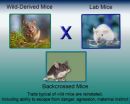(Press-News.org) This news release is available in French.
Ottawa, ON -- A new study just published in the journal Applied Physiology, Nutrition, and Metabolism investigated the value of the Pre-Exhaustion (PreEx) training method and found that that the various arrangements of different exercise protocols is of less relevance than simply performing resistance training exercises with a high intensity of effort within any protocol. As resistance training is becoming a major intervention for health and disease prevention, improved understanding in this area is increasingly important.
PreEx training is based on the principle that the targeted muscles can be pre-exhausted with isolation exercises immediately prior to a compound exercise – thereby providing greater stimulation to the target muscles. Contrary to popular belief that this major stimulus from resistance training revolves around the high degree of effort at the end of a set of repetitions, this study found that the order of exercises or interval between sets has minimal to no added benefits.
The authors of the study were James Fisher and James Steele of Southampton Solent University and Dave Smith of Manchester University in the UK along with Luke Carlson of Discover Strength, Plymouth, Minnesota.
"This research study represents a real work-out, by real people in a real gym not a laboratory gym as in much strength training research. Our results suggest that exercise order and rest interval make no difference to chronic strength increases following 12 weeks of training, but rather should be chosen based on personal preference," explained James Fisher, lead author.
"In addition, whilst scientific research in trained participants is lacking, maybe as a result of the diminished gains compared to untrained persons, the present study shows that significant strength increases can continue as a result of brief (~23 minutes) and infrequent (2 x / week) resistance exercise when intensity of effort is maximised. This research demonstrates ecological validity as well as scientific rigour; it shows practical results from an approach to resistance exercise that most people can immediately utilise."
INFORMATION:
" The effects of pre-exhaustion, exercise order and rest intervals in a full body resistance training intervention " (DOI: dx.doi.org/10.1139/apnm-2014-0162) was published today in the journal Applied Physiology, Nutrition, and Metabolism.
Does your training routine really need to be that complicated?
New study suggests exercise order and rest interval make no difference to chronic strength increases following 12 weeks of training
2014-08-05
ELSE PRESS RELEASES FROM THIS DATE:
Surprise discovery could see graphene used to improve health
2014-08-05
A chance discovery about the 'wonder material' graphene – already exciting scientists because of its potential uses in electronics, energy storage and energy generation – takes it a step closer to being used in medicine and human health.
Researchers from Monash University have discovered that graphene oxide sheets can change structure to become liquid crystal droplets spontaneously and without any specialist equipment.
With graphene droplets now easy to produce, researchers say this opens up possibilities for its use in drug delivery and disease detection.
The findings, ...
Warning to parents on high acidity drinks
2014-08-05
Dental researchers at the University of Adelaide are warning parents of the dangers of soft drinks, fruit juice, sports drinks and other drinks high in acidity, which form part of a "triple-threat" of permanent damage to young people's teeth.
For the first time, researchers have been able to demonstrate that lifelong damage is caused by acidity to the teeth within the first 30 seconds of acid attack.
The researchers say drinks high in acidity combined with night-time tooth grinding and reflux can cause major, irreversible damage to young people's teeth.
"Dental erosion ...
Pheromones regulate aggression of non-mother female mice toward pups in wild-derived mice
2014-08-05
Laboratory mice are one of the most common animal models used in biological and medical research. Thousands of laboratory mouse strains are produced by artificial selection – the process by which humans breed animals over dozens of generations for particular traits. This has led to the domestication of mice: strengthening specific qualities that make them well-adapted for research under laboratory conditions, such as rapid reproduction, while eliminating characteristics that are not conducive to research, for example, aggression, the desire and ability to escape from danger, ...
Eating more dietary pulses can increase fullness, may help manage weight
2014-08-05
TORONTO, Aug. 5, 2014 – Eating about one serving a day of beans, peas, chickpeas or lentils can increase fullness, which may lead to better weight management and weight loss, a new study has found.
A systematic review and meta-analysis of all available clinical trials found that people felt 31 per cent fuller after eating on average 160 grams of dietary pulses compared with a control diet, according to senior author Dr. John Sievenpiper of St. Michael's Hospital's Clinical Nutrition and Risk Factor Modification Centre.
His group's findings were published in the August ...
Social networking is key to helping bugs spread, study shows
2014-08-05
Fresh discoveries about how bacteria co-operate with each other when causing infection could help scientists identify animal diseases that might transmit to people.
Bugs that can co-operate best with each other are most likely to be able to jump to new species, including humans, a new study shows.
Bacteria interact by releasing molecules to help them adapt to their environment – for example, when killing competing infections in their victim. They co-ordinate these actions by releasing tiny amounts of chemicals as signals.
Bacteria that can co-operate to create an ...
LEDs made from 'wonder material' perovskite
2014-08-05
A hybrid form of perovskite - the same type of material which has recently been found to make highly efficient solar cells that could one day replace silicon - has been used to make low-cost, easily manufactured LEDs, potentially opening up a wide range of commercial applications in future, such as flexible colour displays.
This particular class of semiconducting perovskites have generated excitement in the solar cell field over the past several years, after Professor Henry Snaith's group at Oxford University found them to be remarkably efficient at converting light to ...
Smart bacteria help each other survive
2014-08-05
The body's assailants are cleverer than previously thought. New research from Lund University in Sweden shows for the first time how bacteria in the airways can help each other replenish vital iron. The bacteria thereby increase their chances of survival, which can happen at the expense of the person's health.
The bacteria Haemophilus influenzae is a type of bacteria in the respiratory tract that can cause ear infections and worsen the prognosis for COPD patients. In rare cases, it can also lead to meningitis and septicaemia.
"By accepting help from a specific protein, ...
Carnegie Mellon photo editing tool enables object images to be manipulated in 3-D
2014-08-05
PITTSBURGH—Editors of photos routinely resize objects, or move them up, down or sideways, but Carnegie Mellon University researchers are adding an extra dimension to photo editing by enabling editors to turn or flip objects any way they want, even exposing surfaces not visible in the original photograph.
A chair in a photograph of a living room, for instance, can be turned around or even upside down in the photo, displaying sides of the chair that would have been hidden from the camera, yet appearing to be realistic.
This three-dimensional manipulation of objects in ...
Rituals can help older people remember to take their asthma meds
2014-08-05
Storing it in the bathroom and making it part of a daily routine may be helpful advice that doctors can give their older asthmatic patients who struggle to remember to take their daily prescribed medication. This advice comes from Alex Federman, Associate Professor of Medicine at the Icahn School of Medicine in New York City, senior author of a study which discusses how elderly asthmatics cope with taking their inhaled corticosteroid medication as prescribed. The findings appear in the Journal of General Internal Medicine, published by Springer.
The regular use of such ...
Clues to the ageing of tendons unlocked for the first time
2014-08-05
University of Liverpool scientists have examined the mechanisms that cause ageing in the tendons of horses, opening up the possibility of better treatment for humans.
It has been understood for many years that tendons are highly prone to injury and that this likelihood increases as they age. Why this happens, is currently poorly understood
Now, using samples taken from young and old horses, which have similar tendon properties to those of humans, the team of researchers, which also included scientists from Queen Mary University of London, performed a range of tests ...
LAST 30 PRESS RELEASES:
Groundbreaking discovery turns household plastic recycling into anti-cancer medication
Blocking a key inflammatory pathway improves liver structure and vascular function in cirrhosis, study finds
Continuous spread: Raccoon roundworm detected in nine European countries
HKUST Engineering researchers developed a novel photodetector to enhance the performance of on-chip light monitoring
Strategic river sensors could have forewarned of Texas Camp flood disaster
Drone sampling of whale breath reveals first evidence of potentially deadly virus in Arctic
Roman soldiers defending Hadrian’s Wall infected by parasites, study finds
Pinochet’s prisoners were tormented with music but still found solace in it, a new book reveals
Fertility remains high in rural Tanzania despite access to family planning
AI-assisted device can improve autism care access
Kinetic careers
Uncovering how parasitic plants avoid attacking themselves to improve crop resistance
Nanoparticle vaccine strategy could protect against Ebola and other deadly filoviruses
Study finds brain care score can predict risk of stroke across racial groups
Key lung immune cells can intensify allergic reactions
Do hormones explain why women experience more gut pain?
New materials conduct ions in solids as easily as in liquids
Breakthrough of the Year: Renewable energy begins to eclipse fossil fuel-based sources
LLM use is reshaping scientific enterprise by increasing output, reducing quality and more
Introducing LightGen, a chip for ultra-fast, ultra-efficient generative AI
Astronomers see fireworks from violent collisions around nearby star
ACC/AHA issue new guideline on managing congenital heart disease in adults
Cosmic crash caught on camera
Is talented youth nurtured the wrong way? New study shows: top performers develop differently than assumed
Ants: An untapped resource in the development of antibiotics?
Archaeologists use AI to create prehistoric video game
Mitochondria migrate toward the cell membrane in response to high glucose levels
Tiny viral switch offers hope against drug-resistant bacteria
Most parents aware of early peanut introduction guidelines, but confused about details
HPV vaccine can protect against severe lesions of the vulva and vagina
[Press-News.org] Does your training routine really need to be that complicated?New study suggests exercise order and rest interval make no difference to chronic strength increases following 12 weeks of training




